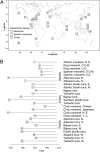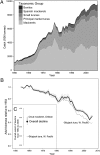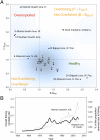Global population trajectories of tunas and their relatives
- PMID: 22143785
- PMCID: PMC3251139
- DOI: 10.1073/pnas.1107743108
Global population trajectories of tunas and their relatives
Abstract
Tunas and their relatives dominate the world's largest ecosystems and sustain some of the most valuable fisheries. The impacts of fishing on these species have been debated intensively over the past decade, giving rise to divergent views on the scale and extent of the impacts of fisheries on pelagic ecosystems. We use all available age-structured stock assessments to evaluate the adult biomass trajectories and exploitation status of 26 populations of tunas and their relatives (17 tunas, 5 mackerels, and 4 Spanish mackerels) from 1954 to 2006. Overall, populations have declined, on average, by 60% over the past half century, but the decline in the total adult biomass is lower (52%), driven by a few abundant populations. The trajectories of individual populations depend on the interaction between life histories, ecology, and fishing pressure. The steepest declines are exhibited by two distinct groups: the largest, longest lived, highest value temperate tunas and the smaller, short-lived mackerels, both with most of their populations being overexploited. The remaining populations, mostly tropical tunas, have been fished down to approximately maximum sustainable yield levels, preventing further expansion of catches in these fisheries. Fishing mortality has increased steadily to the point where around 12.5% of the tunas and their relatives are caught each year globally. Overcapacity of these fisheries is jeopardizing their long-term sustainability. To guarantee higher catches, stabilize profits, and reduce collateral impacts on marine ecosystems requires the rebuilding of overexploited populations and stricter management measures to reduce overcapacity and regulate threatening trade.
Conflict of interest statement
The authors declare no conflict of interest.
Figures




References
-
- Myers RA, Worm B. Rapid worldwide depletion of predatory fish communities. Nature. 2003;423:280–283. - PubMed
-
- Sibert JR, Hampton J, Kleiber P, Maunder M. Biomass, size, and trophic status of top predators in the Pacific Ocean. Science. 2006;314:1773–1776. - PubMed
-
- Worm B, et al. Impacts of biodiversity loss on ocean ecosystem services. Science. 2006;314:787–790. - PubMed
-
- FAO . The State of World Fisheries and Aquaculture 2010. Rome: FAO; 2010.
Publication types
MeSH terms
LinkOut - more resources
Full Text Sources
Miscellaneous

